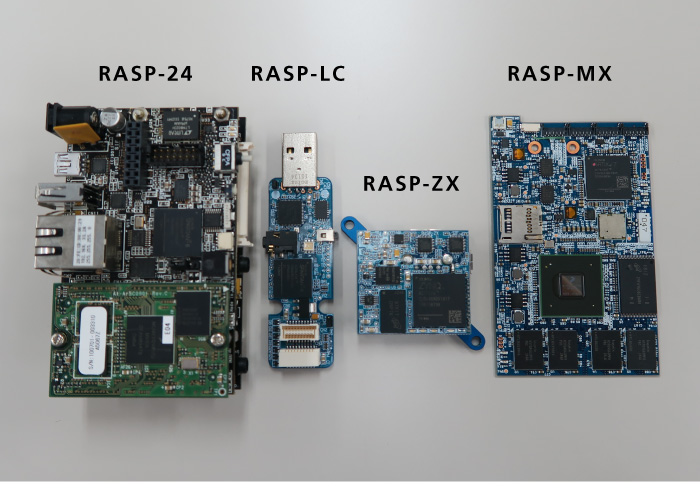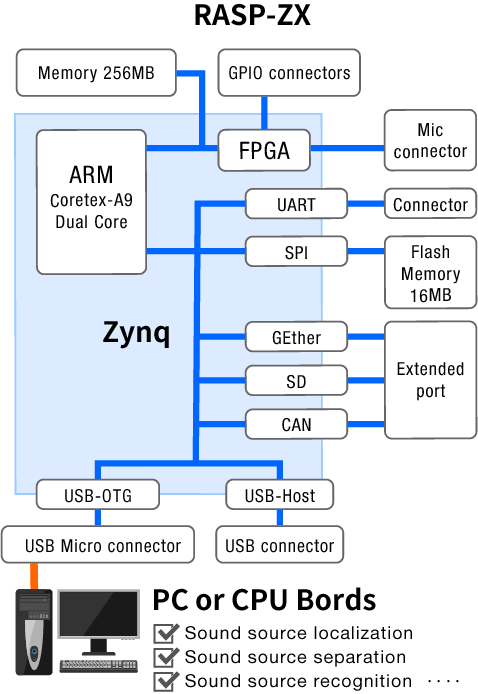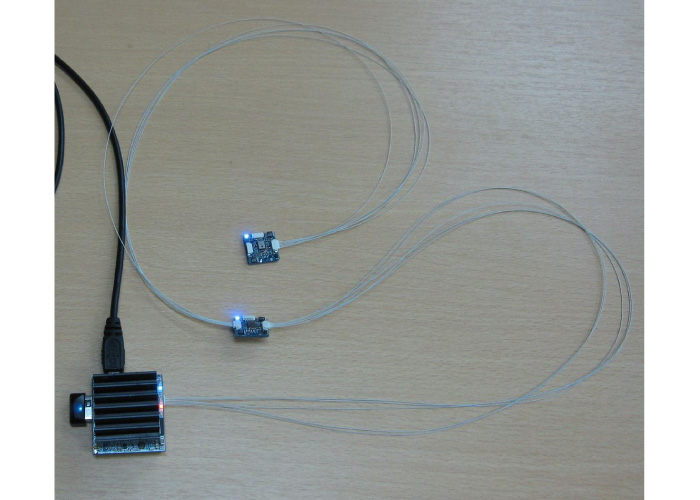Products and Services
Advanced Sound Technology Products: Front Ends for Acoustic and Audio Signal Processing
RASP Series
RASP (Real-time Array Signal Processor) is the ingenious device, being packed all functions to need for voice and sound processing such as sampling, filtering, network service and file management into compact body.

Features of RASP
What makes RASP unique is its architecture, which includes an FPGA and a processor, in addition to the sampling capability. The FPGA performs real-time digital signal processing such as FFT and filtering, while the processor performs higher-order processing such as interfacing with external devices. By dividing the processing among them, it is possible to cover all the front-end functions of voice and acoustic processing. As an example, the connection diagram of the RASP-ZX is shown in the figure below.

The cascade microphone used in the RASP-ZX uses a proprietary (patented) technology to connect multiple microphones in a cascade. Until now, the number of microphones required a number of cables, which was considered a major problem, to fit them into a limited space. On the other hand, Cascade microphones allow for wiring in a limited space in the device, by the microphones are connected in series with each other and there is always a single cable regardless of the number of microphones.

History of RASP Development
| 2000 | Started development of acoustic signal sampling and processing system. |
|---|---|
| 2001 | Exhibited at the RWC2001 Final Results Exhibition. |
| 2001- 2002 | In response to By the request from the National Institute of Advanced Industrial Science and Technology (AIST), we jointly developed a hardware architecture that integrates acoustic signal sample function, FPGA for real-time processing, MPU for advanced processing, and a communication environment that can be connected to a host system. |
| 2003 | Presented the above system at the Acoustical Society of Japan. |
| 2004 | We presented RASP-1 at GSPx. This is the first time we use the name RASP. |
| 2005 | Press release of RASP installation in "HRP-2 Promethe". Started selling RASP-2 as our own product. |
| 2010 | Development and sales of RASP-24 started. |
| 2012 | Development and sales of RASP-LC started. Developed and started sales of KURAGE (joint development with Otake Laboratory, Chiba University) |
| 2013 | Development and sales of RASP-ZX started. |
| 2014 | Received the 19th Practical Application Technology Award at the Robotics Society of Japan. |
| 2015 | Development and sales of RASP-MX started. |
| 2017 | Cascade microphones patented. |
The development of RASP started with the original idea of mounting FPGA and a processor on a sampling board.
With the operating frequency and number of threads of processors at that time, it was difficult to perform multi-channel signal processing in real time.
In addition, FPGA at the time had a limited number of gates, making it impossible to implement advanced logic.
Therefore, RASP was developed to be a standalone device that can realize both real-time signal processing and advanced signal processing by incorporating both a processor and FPGA.
For more advanced signal processing in the modern era, access to AI and big data has become a technological trend, and connectivity has become more important than standalone processing. Against this background, the role of the processor has become primarily to provide an interface for data transfer, and there is no longer any need to demand high performance from the processor.
In addition, the hardware of the current product uses only FPGA to implement the RASP architecture, since it is now possible to put the processor core in the FPGA itself.
As you can see, RASP is constantly evolving in response to technological trends and user’s needs.


